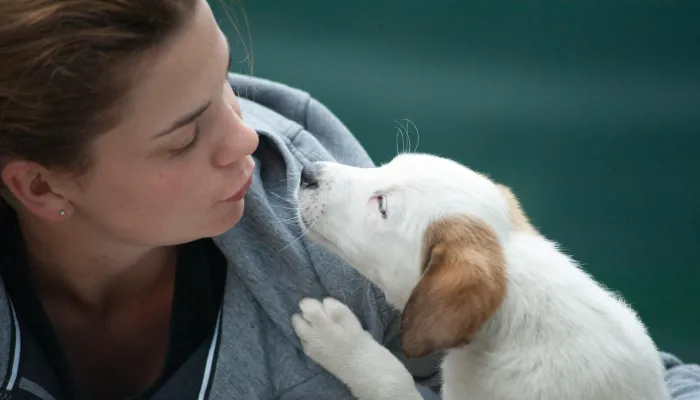“How do I say “I love you” in dog translator?” The answer isn’t as complicated as it seems. A dog understands affection in many ways, and getting that message to them is not rocket science. Dogs use body language, sounds, and behaviors to communicate with other dogs or humans, words are not a part of it.
Although the phrase dog translator sounds like a feature in some futuristic movies, the reality is that it is not as complicated as you think it is – it is just understanding your pup’s love language.
This blog will demystify how dogs communicate so that you have a better relationship with your furry friend. Now let us get to the heartwarming part- the long tail wags, twitches in the ears, and of course slobbery kisses!

Understanding Dog Communication: It’s Not Just Barks!
While dogs do not speak any human languages, they do know how to deliver non-verbal communication perfectly. To answer the initial question”How Do I Say “I Love You” in Dog Translator?”, we first need to understand the dialect of dogs in order to “translate” it.
The Basics of Dog Body Language
- Tail Wagging: If the dog wags their tail and it is relaxed, chances are the dog is happy.
- Ears Forward: The Dog could either be interested or curious.
- Soft Eyes: Trust, and signs of relaxation are shown through squinty eyes.
- Play Bow: Your dog wants to play with you, as he is in a position where the front paws are down and the rear end is up.
Vocalizations and What They Mean
- Whining: When a dog is showing signs of anxiety or seeking your attention.
- Barking: What most people consider as ‘noise’ could represent a dog’s excitement, alertness or boredom.
- Howling: Often these signals are in support of social behavior, for example responding to sounds.
You won’t need a high-tech Dog Translator to translate what your dog is trying to say as you will start to ‘hear’ them with time if you note these signals.
Decoding “I Love You” in Dog Language
So How Do I Say “I Love You” in Dog Translator? It’s simple, let’s translate human love into simple dog-respectful behavior.
Signs Your Dog is Saying “I Love You”
- Leaning against you: A sign of trust and closeness.
- Bringing you toys: Symbolizes their affection.
- Licking your face: Your puppy kissing you!
- Sleeping next to you: You provide them with comfort.
How Dogs Perceive Human Affection
- To dogs, love means care, play, and some petting. They make sense out of the word ‘love’ as a Russo saying that a scratch on the belly or sharing of food simply means more than words used.
You deepen your connection when you understand how dogs show love. Remember the most important thing: they love you for a good reason!
Translating Human Love to Dog Language
With the signals given above, let’s answer the question: How do I say “I love you” in Dog Translator? The answer lies in your behavior.
5 Ways to Tell Your Dog “I Love You”
- Slow blinks: Look at them and blink slowly it distracts and calms them down.
- Gentle petting: Best done on their favorites as the waist area, head, or neck.
- Daily playtime: Games of fetching the ball or tug of war are best.
- Part of a strategy: Keeping meals and walks at specific times helps your dog to feel safe.
- Relaxed Attention: No yelling, dogs do well in calm settings.
Love is multilingual, but a heart knows no boundaries. When it comes to dogs, one must learn to communicate effectively for the connection to deepen.
Understanding Communication of Dogs vs Humans
Improving communication is possible by learning the nuances of dog gestures versus human actions. As you know, dogs cannot speak, but this side-by-side comparison will be of help to you!
| Dog Gesture | Human Actions |
|---|---|
| Tail wagging | Smiling or laughing |
| Bringing a toy | Giving a gift |
| Licking your hand | Saying “Thank you” |
| Rolling over for belly rubs | Trusting you completely |
Your dog will certainly understand and appreciate the extra effort you are trying to make.
Frequently Asked Questions
If you want answers, you are in the right place. The most important questions that people tend to ask regarding dog gestures and communication with them are listed here.
My dog is shy. How do I say “I love you” in Dog Translator?
Calmly express your affection by using soft hand gestures like slowly sitting next to them or treating them with a flavor they like.
Do dogs understand verbal “I love you”?
After some time, they begin to connect your words with your body language and tone of voice.
What are the signs my dog loves me?
Other follow-up signs or questions like trust, caring body language, and wanting to be around you are all proof most dogs love their owners.
Please do not hesitate to contact us for your other queries. There is always more to learn about how your dog communicates.
Conclusion
How do I say “I love you” in Dog Translator? The answer is: being patient, observing thoughtfully, and throwing in some sincere gestures. Although we will probably never get to a point where we need an actual Dog Translator, our dog’s communication style certainly helps us understand them better.
Jumping and play fighting with your dog is his way of saying, “You’re loved.” So leave the dictionary behind, grab a tennis ball, and get ready to go out and show your love! Because dogs don’t just know how to bark; they also know how to express love!
